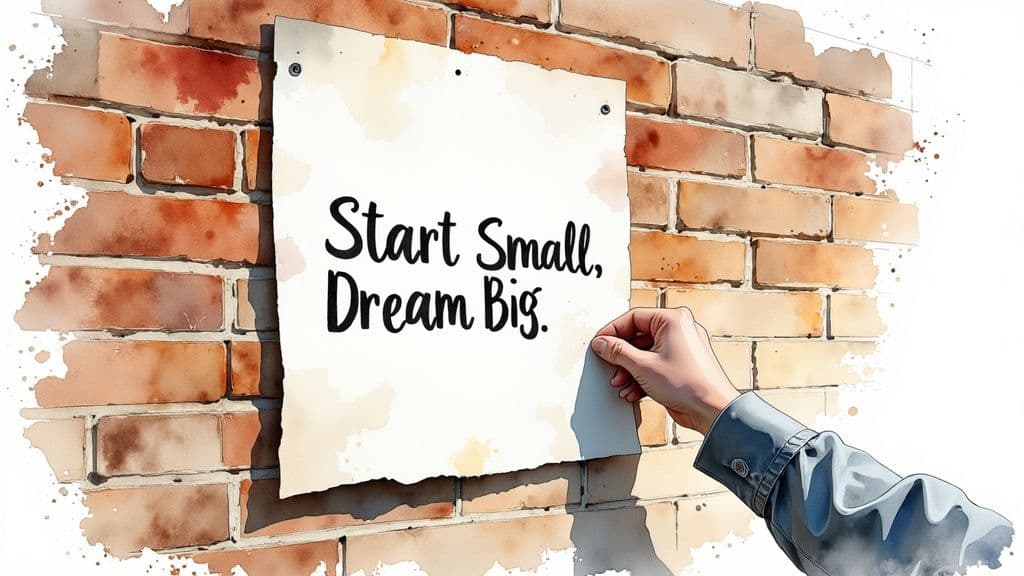
Create a Perfect Bricks Texture Seamless with AI
Learn how to create a flawless bricks texture seamless design using AI. Our friendly guide has actionable tips for realistic, tileable patterns.
Discover proven strategies for startup marketing on a budget. Learn how to grow your business with low-cost, high-impact tactics that deliver real results.

Instastock Team
October 3, 2025 • 15 min read
When you're running a startup on a shoestring budget, smart marketing isn't about outspending your rivals—it’s about out-thinking them. The secret is to nail down your strategy before you even think about spending a single pound. Getting this foundation right means every bit of effort and cash you put in later will work that much harder for you.
 Before you dive into writing social media posts or setting up Google Ads, you need a map. Without one, you're just throwing money into the wind and hoping for the best. For a startup, that map is your marketing foundation. This early work isn't always exciting, but it's absolutely essential for growing without a massive budget.
Before you dive into writing social media posts or setting up Google Ads, you need a map. Without one, you're just throwing money into the wind and hoping for the best. For a startup, that map is your marketing foundation. This early work isn't always exciting, but it's absolutely essential for growing without a massive budget.
Making careful, deliberate choices is the name of the game, especially right now. Across the UK, businesses are feeling the pinch. The IPA Bellwether Report for Q1 2025 revealed that nearly a quarter (24.2%) of companies had to cut their marketing spend because of rising costs.
But there's good news. The same report shows a wave of optimism, with 36% of firms planning to boost their budgets in the next year, focusing squarely on digital strategies that deliver measurable results. This just goes to show how vital it is to have a plan that makes every pound count.
You absolutely have to go deeper than surface-level demographics. "Females aged 25-35 in London" isn’t an audience; it’s a vague starting point. To make an impact, you need to create a buyer persona so detailed it feels like you're talking about a real person.
Get specific by asking the right questions:
Think of your value proposition as your elevator pitch. It’s a short, sharp statement explaining exactly why someone should choose you over the competition. It's not just a catchy slogan; it’s the heart of your entire marketing message.
A simple but powerful formula to follow is: We help [your target customer] to [achieve a goal] by [your unique solution].
For instance, a startup offering a sustainable coffee subscription could say: "We help eco-conscious UK professionals enjoy specialty coffee at home by delivering ethically sourced beans in plastic-free packaging." It’s crystal clear, focused on the benefit, and speaks directly to its ideal customer.
Your value proposition needs to be front and centre on your website. If a visitor can't figure out what you do and who you do it for in about five seconds, they're gone.
A consistent brand is a trusted brand. It makes you recognisable and memorable, and it goes way beyond just a cool logo. It’s your colour palette, your fonts, your tone of voice—the whole vibe you want to create.
You don't need a pricey agency for this at the start. You can find out more by reading our guide on how to create brand guidelines for your startup.
For a broader look at getting your digital presence off the ground, this comprehensive guide to digital marketing for small businesses is a fantastic resource for doing it all without a big budget.

Alright, with your groundwork sorted, it's time to roll up your sleeves and get stuck in. When you're a startup, marketing on a tight budget is all about swapping financial spend for sweat equity. This is especially true in the digital world.
Let's put aside any thoughts of expensive ad campaigns for now. The real goal is to build an authentic, organic presence that pulls customers in naturally. We're talking about creating an online footprint that works for you 24/7, drawing in the right people without you having to constantly throw money at it. It's a marathon, not a sprint, but for a startup, it's the only sustainable way to grow.
Content marketing is the absolute engine of most successful low-budget strategies. It's simple, really: create genuinely helpful content—think blog posts, detailed guides, or short videos—that actually solves a problem for your ideal customer. Instead of shouting, "Buy my product!" you're quietly showing them, "I get your problem, and I can help you fix it."
Imagine a fintech startup that wants to help freelancers. They could write a brilliant guide called "The Ultimate Guide to Self-Assessment Tax Returns for UK Creatives." This piece doesn't directly sell their accounting software. What it does do is position them as a trusted expert, attracting potential users who are actively looking for that exact information.
Plenty of small businesses in the UK have cottoned on to this. Even with tight budgets, it's common to see an allocation of £1,500 to £5,000 monthly for content marketing, which can cover everything from writing to social media promotion. As these insights on UK content marketing budgets explain, it's a savvy investment that pays back in organic growth over time.
Search Engine Optimisation (SEO) sounds a lot more intimidating than it is. At its core, it’s just about making it dead simple for search engines like Google to find, understand, and rank your content. You don't need to be a technical whizz to make a real impact.
Start with these straightforward on-page SEO basics:
yourwebsite.co.uk/tax-guide-for-freelancers is infinitely better than yourwebsite.co.uk/p=123.And if you have a physical location, local SEO isn't just nice to have—it's essential. The first thing you should do is set up and fully optimise your Google Business Profile. It’s completely free and one of the most powerful moves you can make. Double-check your address, phone number, and opening hours, and gently encourage happy customers to leave reviews. This literally puts you on the map when locals search for what you offer.
"Your early SEO efforts aren't about ranking number one for a competitive term overnight. They're about capturing the low-hanging fruit—the specific, long-tail keywords that signal a user is ready to solve a problem your startup addresses."
Forget about vanity metrics like follower counts. For a startup, social media is about building a real, breathing community. The trick is to pick one or two platforms where your ideal customers actually hang out and go deep, rather than spreading yourself thin across every single channel.
A UK-based sustainable fashion brand, for instance, is going to have a much better time on Instagram and Pinterest than on LinkedIn. Their focus should be on creating beautiful, visual content that tells their brand story, highlights their values, and genuinely engages with followers in the comments and DMs. It’s all about connection.
Choosing where to invest your time is half the battle. This table breaks down where your efforts can make the most impact when you're just starting out.
| Channel | Primary Focus | Typical Startup Cost (Monthly) | Effort Level |
|---|---|---|---|
| Content & SEO | Building long-term authority and organic traffic. | £0 - £250 (for tools) | High & Consistent |
| Social Media | Community building and direct engagement. | £0 (organic efforts) | Medium & Daily |
| Local SEO | Capturing local search intent and foot traffic. | £0 (Google Business Profile) | Low & Ongoing |
Each channel requires a different type of commitment, but they all share one rule: listen more than you talk. Join conversations, answer questions, and share useful stuff from others in your niche. Think of yourself as a helpful member of an online neighbourhood, not a billboard advertiser. That human touch is what builds trust and turns followers into true fans who will champion your brand for you.

Let's ditch the old-school marketing playbook of just shouting your message into the void. For a startup, real marketing power doesn't come from a massive ad budget; it comes from a small, fiercely loyal group of people who genuinely believe in what you're doing.
Honestly, your first 100 fans are worth more than 10,000 passive followers. Why? Because they'll become your most passionate, authentic marketing team.
The goal here is to shift your focus from casting a wide net to building deep, meaningful connections. It’s all about creating a community that doesn't just buy from you but actively champions your brand to their friends and family. When people feel like they’re part of your story, they start marketing for you, and you simply can't buy that kind of word-of-mouth endorsement.
This whole journey starts by treating your earliest customers like absolute VIPs. These aren't just transactions; these people are the founding members of your tribe. Your job is to make them feel seen, heard, and genuinely appreciated for taking a chance on you.
So, how do you actually do that? It's simpler than you might think. It all boils down to personal, one-on-one engagement.
This kind of direct interaction builds an emotional bond that slick marketing campaigns just can't touch. It transforms customers into advocates who will defend and promote your brand with genuine excitement.
User-generated content (UGC) is the absolute gold standard for startups on a shoestring budget. It's authentic, it's trustworthy, and the best part? It's completely free. Your mission is to gently nudge your community to create content that features your brand.
Imagine a small, UK-based coffee roaster. They could run a simple Instagram contest asking customers to share photos of their "morning brew moment" using a unique hashtag. The prize doesn't need to be extravagant—a free bag of their best coffee or some branded merch is often more than enough to get people excited.
The real magic of UGC is the social proof it provides. When potential customers see real people enjoying your product, it builds trust in a way that a polished advertisement never could.
To make these visuals truly resonate, it helps to understand the basics of telling a great story. You can get a better handle on this by learning what is visual storytelling and how it can really bring your brand’s message to life.
Remember, you're not in this alone. There are tons of other UK businesses out there targeting a similar audience but not directly competing with you. Teaming up with them is one of the smartest, most cost-effective growth hacks you can pull off.
Think about businesses that complement what you do. If you sell artisan gin, a partnership with a local tonic water company or a quirky glassware maker is a no-brainer.
Here are a few ways you can collaborate for a win-win:
These partnerships give you a warm introduction to a new, relevant audience that already trusts the brand you’re partnering with. It’s far more effective than any cold outreach ever could be.

Paid advertising can feel like a high-stakes game for a new startup. We've all heard the horror stories of founders burning through their precious cash on Meta or Google ads with almost nothing to show for it. But here’s the thing: when you use them with a bit of strategy, they can be an incredible growth engine, not a budget black hole.
The secret is to forget everything you know about just "boosting posts." That’s a fast track to wasting money. Instead, think of it as running small, hyper-focused experiments designed to test, learn, and deliver real results right from the start. Every single pound you spend needs to be an investment in either data or conversions.
In the UK, the pressure to make every penny count is immense. On average, marketing budgets are now 9.4% of a company's total revenue, but a whopping 59% of UK CMOs feel their budgets just aren't big enough to hit their targets. This squeeze is pushing everyone towards smarter, data-led strategies, which is exactly the mindset a startup needs. You can get a deeper look at these marketing budget trends and insights to see how the landscape is shifting.
Your biggest asset as a startup isn't a massive budget; it's your ability to be nimble. You can test ideas and pivot far quicker than any corporate giant. So, apply that thinking to your first paid ad campaign.
Start with a tiny daily budget—I’m talking £5 or £10 per day on a platform like Meta. Your goal isn't to land hundreds of sales on day one. It's to gather intelligence. You're trying to find answers to some crucial questions:
Treat this whole process like a science experiment. Only change one variable at a time so you know for sure what’s making a difference. After a week or so, you'll have a much clearer picture of what works and what doesn't, all without having risked a serious amount of cash.
The real magic of platforms like Google and Meta is in their targeting tools. Don't just aim your ads at a broad demographic and hope for the best. You need to get granular, using the customer data you already have.
One of the most powerful moves you can make is creating a lookalike audience. If you have an email list of your first 100 customers, you can upload it to Meta. The platform then analyses the common traits of these people and finds new users who are just like them. This is infinitely more effective than guessing who your ideal customer might be.
Another brilliant tactic is retargeting. By installing a small snippet of code (called a pixel) on your website, you can show ads specifically to people who've already visited. Say someone added a product to their cart but got distracted. A gentle, well-timed ad reminding them of what they left behind can be incredibly effective at nudging them over the finish line.
Your paid ad strategy shouldn't be about reaching everyone. It should be about reaching the right people, over and over, until they are ready to convert. A small, highly engaged audience is always better than a large, indifferent one.
It’s so easy to get caught up in vanity metrics like impressions or likes. While they're not completely meaningless, they don't pay the bills. For an early-stage startup, the only metric that really counts is conversions.
Before you spend a single penny, define what a conversion actually means for your business. It might be:
Setting up conversion tracking on your website isn't optional; it's essential. It's the only way you’ll ever know which ads are driving value and which are just draining your bank account. With proper tracking, you can figure out your Cost Per Acquisition (CPA)—the exact amount you're spending to get one new customer. That one number will tell you if your campaign is a winner.
By starting small, targeting like a pro, and obsessing over conversions, you can turn paid ads into a predictable and scalable part of your marketing machine. Only once you've found a profitable formula should you even think about dialling up the spend.
You don't need a massive budget to make a real impact with your marketing. In fact, some of the most powerful tools out there won't cost you a penny. I've pulled together a list of my favourite free (or freemium) resources that let you punch well above your weight, making your startup look and operate like a much bigger company.
Think of these tools as your secret weapons. They cover everything from digging into customer data to creating eye-catching designs and managing your social media. By combining a few of these, you can build a professional marketing stack that grows with you.
Before you do anything else, you need to understand what's actually happening on your website. Who's visiting? How did they find you? What do they click on? Without this information, you're just guessing.
Thankfully, the industry-standard tools for this are completely free.
Google Analytics: This is non-negotiable. Seriously, install it now. It gives you a treasure trove of data on your website traffic and user behaviour. It's the only way you'll know if your marketing efforts are actually working.
AnswerThePublic: This one's a goldmine for content ideas. Just type in a keyword, and it shows you all the questions people are plugging into search engines. It's the perfect way to find out what your audience is desperate to know, giving you an endless supply of ideas for blog posts and FAQs.
Using these tools means your strategy is built on solid data, not just what you think people want. That’s how you make every hour you spend on marketing count.
Not too long ago, creating professional-looking content meant forking out for expensive software or hiring a designer. Those days are gone. A new wave of tools has completely levelled the playing field.
For anything visual, Canva is an absolute game-changer. The free version is incredibly generous, offering thousands of templates for social media posts, presentations, and blog graphics. Its drag-and-drop interface is so simple, you can create something that looks fantastic in minutes, even with zero design experience.
And it's not just about static images anymore. It's worth exploring how you can use AI for content creation to speed things up, from writing copy to generating unique visuals. You can even get more advanced and learn how to boost user engagement for free with personalized images—a brilliant tactic for grabbing attention when you're just starting out.
Okay, so you’ve got great content. Now what? You need a simple, efficient way to share it and start building a community. Juggling social media channels and an email list can get chaotic fast, but the right free tools can keep you sane.
Your early conversations with customers are everything. A tool that helps you stay consistent and professional, even when you're stretched thin, is worth its weight in gold.
To help you get started, I've put together a quick list of some of the best free tools that marketing pros rely on. These are perfect for getting your tech stack off the ground without spending a single pound.
| Category | Tool Name | Key Free Feature |
|---|---|---|
| Email Marketing | Mailchimp | The free plan lets you manage up to 500 contacts and send 1,000 emails a month—more than enough to get your first newsletter off the ground. |
| Social Scheduling | Buffer | Connect up to three social accounts and schedule 10 posts in advance for each. This is a lifesaver for maintaining a consistent presence online. |
| Project Management | Trello | Keep your marketing calendar and to-do lists organised with a simple, visual Kanban board. It’s perfect for keeping your strategy on track. |
By pulling these resources together, you create a powerful, cost-effective system. You'll have everything you need to analyse your performance, create brilliant content, and get it in front of the right people, all without breaking the bank.
When you're just starting out, especially here in the UK, the world of marketing can feel like a minefield. You've got big ambitions but a tiny budget, and it's easy to feel overwhelmed. Let's cut through the noise and tackle some of the most common questions I hear from founders.
This isn't about lofty, academic theories. It's about practical, real-world advice you can actually use today. Getting these fundamentals right from the beginning can be the difference between gaining real traction and just spinning your wheels.
With a budget that’s close to zero, your time becomes your most precious currency. The single best thing you can do is pour your energy into creating one piece of phenomenal 'pillar' content. I'm not talking about a quick blog post, but a truly comprehensive guide that solves a significant, nagging problem for your ideal customer.
Think of it like this: instead of writing ten mediocre articles that barely make a ripple, you create one definitive resource that becomes the go-to answer. For example, if you’re a startup selling eco-friendly packaging, you could create "The Ultimate Guide to Sustainable Shipping for UK E-commerce Startups."
Once that masterpiece is live, your work has just begun. Don't just publish it and pray. Your job is to get it in front of the right people. Jump into relevant LinkedIn groups, find UK-specific subreddits, or join niche industry forums where your audience hangs out. Share your guide as a genuinely helpful resource, not a pushy sales pitch. It’s a brilliant way to build authority and drive your first wave of targeted traffic without spending a penny.
This is a big one. When you're watching every single pound, you absolutely cannot afford to guess what's working. Forget about so-called 'vanity metrics' like social media followers or impressions – they feel good, but they don't pay the bills. You need to zero in on the numbers that directly impact your business growth.
Thankfully, you don't need expensive software to do this.
Your goal here is simple: figure out which of your free or low-cost efforts are actually delivering the goods. This data gives you the confidence to ditch what isn't working and double down on what is, making sure your limited budget is always working as hard as you are.
For a startup on a shoestring budget, the answer is almost always to go deep on one or two channels before even thinking about expanding. Trying to be everywhere at once is a classic rookie mistake. It just spreads your limited time and energy too thin, leading to weak results across the board.
The trick is to choose your channel strategically. Do your homework and figure out where your ideal customers actually spend their time online.
Once you've picked your channel, commit to it. Really learn its quirks, engage with the community, and build a real following. Only once you’re seeing consistent, measurable growth should you even consider adding another channel to the mix. This focused approach helps you build real momentum instead of just making a lot of noise.
Ready to create stunning, on-brand visuals for your marketing without the high costs? Instastock is your AI-powered creative partner. Generate any image you can imagine in seconds, own it completely, and never worry about licensing fees again. Try Instastock for free and create your first five images today.

Learn how to create a flawless bricks texture seamless design using AI. Our friendly guide has actionable tips for realistic, tileable patterns.

Learn to design, customize, and use a unique body outline template with AI. Our guide offers practical tips for artists, designers, and creators.

Discover 7 standout sources for a healthy lifestyle poster. Our guide offers design insights for clinics, schools, and offices to inspire wellbeing.